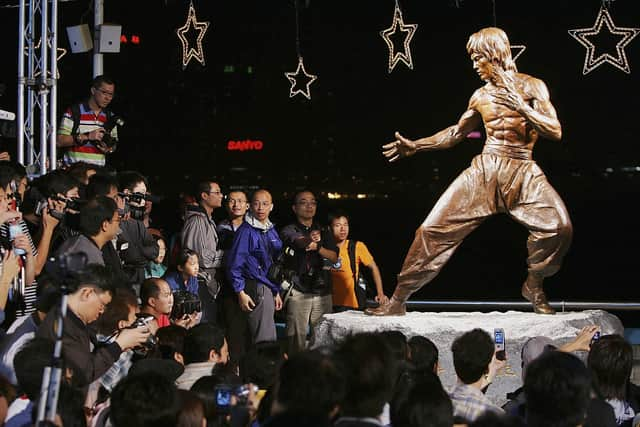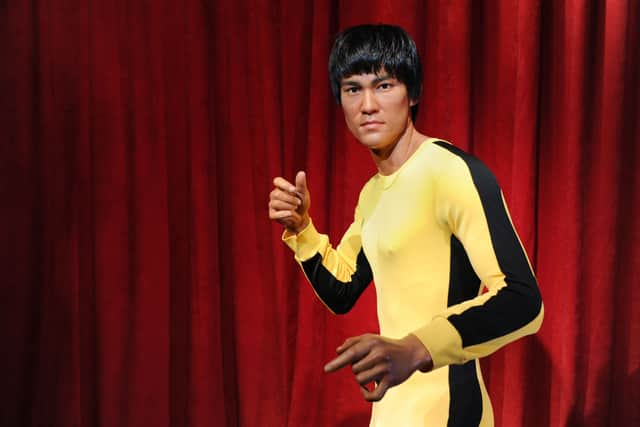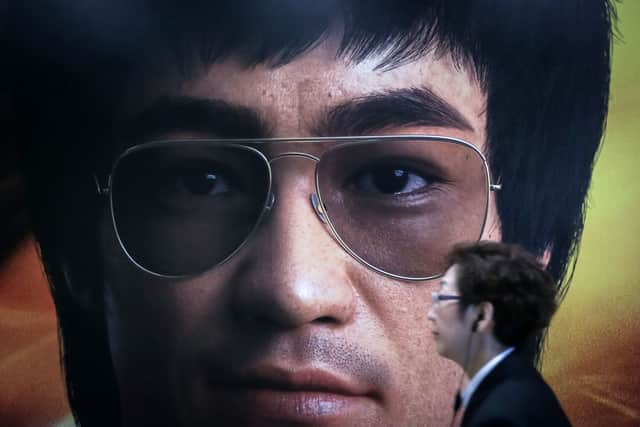As fans honor the 50th anniversary of Bruce Lee's death, his presence in pop culture is still felt
and live on Freeview channel 276
It’s 50 years to the day since Bruce Lee died aged only 32, and yet his ideas and concepts still remain a huge facet of modern popular culture. To say that the martial artist is a pop cultural icon is an understatement - visit any university bedroom and a lot of the time you’ll see a poster for “Enter The Dragon,” or watch “Kill Bill: Volume 1” and you’ll see the same yellow-and-black jumpsuit worn by Uma Thurman that Lee wore in his last film, “Game of Death.”
Reuters reported early today that an influx of Bruce Lee fans have made the “pilgrimage” to his place of birth, Hong Kong, to pay their respects and celebrate the acclaimed star, an icon in his home land as much as he is revered in the west. Standing in front of the life-size bronze statue with Hong Kong's Victoria Harbour behind them, a stream of fans snapped pictures, bowed and laid down flowers.
Advertisement
Hide AdAdvertisement
Hide AdOthers performed moves from Lee's own brand of kung fu: "Jeet Kune Do", and threw "nunchucks" - a chained double truncheon weapon that was popularised by Lee in several films. Those “nunchucks” would also be the cause of “Enter The Dragon” not seeing a full UK release until years after its debut, due to certain individuals mimicking his use of the weapon and ultimately causing themselves more harm than good.
"I have loved Bruce Lee since I was very young," said Bruce Shin, a South Korean that Reuters spoke to who sported a brush cut and large framed sunglasses, imitating Lee. "His body and figure was so mysterious. I wanted to be like him and did weight training for 50 years.”
But even if you’re not an ardent fan of Bruce Lee or martial arts movies, you’ve no doubt witnessed the everlasting influence that the martial artist has had on popular culture. Don’t believe us? Let PeopleWorld demonstrate how Bruce Lee, 50 years after his death, still continues to have a legacy across the entertainment landscape.
How did Bruce Lee influence popular culture years after his death?
The popularity of the Martial Arts movie


There are going to be a sect of people who will argue that the “kung fu” movie was popular already before Bruce Lee entered the fray. But what led to the boom in its popularity in the United States, where it went from sometimes questionably dubbed films shown on local access television (and inspiring Wu Tang Clan, might we add) to something studios realised was a viable, new genre for a growing audience?
Advertisement
Hide AdAdvertisement
Hide Ad“Enter The Dragon,” though not the first martial arts movie made by Western film studios, definitely became the most defining, with Lee already popular with US audiences through his role as Kato in “The Green Hornet.” It achieved immense success and helped bring martial arts cinema to a global audience, making Bruce Lee an international icon and launching what was considered a boom in kung fu movies, with the US itself trying its hand creating its own martial arts superstar - Chuck Norris.
Years later, Jet Li, Jackie Chan and Tony Jaa are household names, even if action movies are not your thing; they all owe a debut to the road Bruce Lee blazed in the West regarding martial arts as a beautiful form of choreography.
Final bosses in video games were a Bruce Lee trope
Your favourite video game might owe a debt of gratitude to Bruce Lee also, especially if you’re a fan of beat-em-ups and fighting games. The concept of a video game character fighting their way through hordes of enemies only to reach the end of the level to take on the big bad before ascending to the next stage was a concept that was made popular through Lee’s final film, 1978’s “Game Of Death.”


In that film Lee, dressed in his iconic yellow-and-black jumpsuit, was tasked to enter a pagoda and fight his way to the top, clearing each floor of enemies and taking on the “boss” of each floor - one of which a student of Lee’s fighting philosophy, basketball great Kareem Abdul-Jabbar.
Advertisement
Hide AdAdvertisement
Hide AdThat concept was lifted by video game creators; what is considered the first side scrolling beat-em-up ever made, "Kung-Fu Master" (also known as "Spartan X" in Japan) saw players control a martial artist named Thomas, who must fight his way through five floors of enemies to rescue his girlfriend Sylvia from the evil Mr. X. Sounds familiar? The game was released in 1984, six years after the release of “Game Of Death.”
Fighting games also made sure they used the likeness of Bruce Lee for their most athletic of martial artists; Ryu and Ken from Street Fighter, Marshall and Forest Law from Tekken and even Liu Kang in Mortal Kombat all owe a debut to Bruce Lee popularising not only the agile nature of his fighting style, but those yelps and screams while delivering blows too. Even the “secret, clandestine fighting tournament” concept was one that was used by, surprise surprise, “Enter The Dragon.”
His fighting philosophy is considered the forerunner of mixed martial arts


Lee has long been considered the “godfather” of mixed martial arts, owing to his groundbreaking fighting philosophy; Jeet Kune Do. Also known as the "Way of the Intercepting Fist," JKD was a revolutionary approach that transcended traditional martial arts styles, promoting practicality, efficiency, and adaptability in combat.
Encouraging practitioners to absorb what is useful and discard what is not, Bruce Lee laid the foundation for a new era of martial arts, one that embraced a holistic and open-minded perspective on combat techniques.
Advertisement
Hide AdAdvertisement
Hide AdCentral to Bruce Lee's legacy was his emphasis on cross-training and integration of techniques from diverse disciplines. He believed in breaking down the barriers between striking, grappling, and submission techniques, long before the concept of mixed martial arts became a widely recognized sport.
By advocating for the assimilation of effective techniques from different martial arts systems, Bruce Lee's philosophy aligned with the principles embraced by modern MMA fighters, who strive to be well-rounded in various disciplines. His teachings urged martial artists to go beyond the confines of tradition, paving the way for eclectic training methods seen in contemporary MMA gyms.
Comment Guidelines
National World encourages reader discussion on our stories. User feedback, insights and back-and-forth exchanges add a rich layer of context to reporting. Please review our Community Guidelines before commenting.
